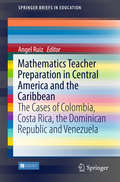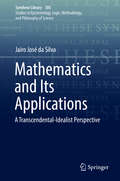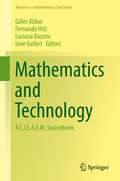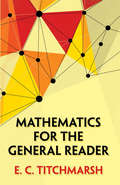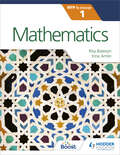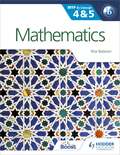- Table View
- List View
Mathematics Teacher Preparation in Central America and the Caribbean: The Cases of Colombia, Costa Rica, the Dominican Republic and Venezuela (SpringerBriefs in Education)
by Angel RuizThis Open Access book is an excellent synthesis of the initial and continuing preparation for Mathematics Teaching in Colombia, Costa Rica, Dominican Republic and Venezuela, from which comparative analyses can be made that show similarities and differences, and highlight various perspectives.In August 2012, a workshop of the Capacity and Networking Project (CANP) of the International Commission on Mathematical Instruction (ICMI) was held in Costa Rica. This CANP brought together for two weeks a group of 66 Mathematics educators, mathematicians, university administrators, and elementary and secondary teachers from Colombia, Venezuela, the Dominican Republic, Panamá and Costa Rica. The goal was to promote progress in Mathematics Education in the region; as such it was a unique experience in the region. One of the most important results of this event was the creation of the Mathematics Education Network of Central America and the Caribbean (REDUMATE). It was organized by persons associated with the Mathematics Education Reform Project in Costa Rica (responsible for the most outstanding and innovative curriculum reform in Latin America) and the Inter-American Committee on Mathematics Education (IACME), which is an official regional multinational organization affiliate of ICMI.This book brings to the international Educational Community an important collection of experiences and ideas in the Mathematics Education of four countries of a region within the heart of the American continent, a region that has been many times forgotten. The dissemination of these results can promote the search for international collaborative actions in a wider scale.
Mathematics and Its Applications: A Transcendental-Idealist Perspective (Synthese Library #385)
by Jairo José da SilvaThis monograph offers a fresh perspective on the applicability of mathematics in science. It explores what mathematics must be so that its applications to the empirical world do not constitute a mystery. In the process, readers are presented with a new version of mathematical structuralism.The author details a philosophy of mathematics in which the problem of its applicability, particularly in physics, in all its forms can be explained and justified. Chapters cover: mathematics as a formal science, mathematical ontology: what does it mean to exist, mathematical structures: what are they and how do we know them, how different layers of mathematical structuring relate to each other and to perceptual structures, and how to use mathematics to find out how the world is.The book simultaneously develops along two lines, both inspired and enlightened by Edmund Husserl’s phenomenological philosophy. One line leads to the establishment of a particular version of mathematical structuralism, free of “naturalist” and empiricist bias. The other leads to a logical-epistemological explanation and justification of the applicability of mathematics carried out within a unique structuralist perspective. This second line points to the “unreasonable” effectiveness of mathematics in physics as a means of representation, a tool, and a source of not always logically justified but useful and effective heuristic strategies.
Mathematics and Technology
by Uwe Gellert Gilles Aldon Fernando Hitt Luciana BazziniThis volume collects most recent work on the role of technology in mathematics education. It offers fresh insight and understanding of the many ways in which technological resources can improve the teaching and learning of mathematics. The first section of the volume focuses on the question how a proposed mathematical task in a technological environment can influence the acquisition of knowledge and what elements are important to retain in the design of mathematical tasks in computing environments. The use of white smart boards, platforms as Moodle, tablets and smartphones have transformed the way we communicate both inside and outside the mathematics classroom. Therefore the second section discussed how to make efficient use of these resources in the classroom and beyond. The third section addresses how technology modifies the way information is transmitted and how mathematical education has to take into account the new ways of learning through connected networks as well as new ways of teaching. The last section is on the training of teachers in the digital era. The editors of this volume have selected papers from the proceedings of the 65th, 66th and 67th CIEAEM conference, and invited the correspondent authors to contribute to this volume by discussing one of the four important topics. The book continues a series of sourcebooks edited by CIEAEM, the Commission Internationale pour l'#65533;tude et l'Am#65533;lioration de l'Enseignement des Math#65533;matiques / International Commission for the Study and Improvement of Mathematics Education.
Mathematics for the General Reader (Dover Books on Mathematics)
by E. C. TitchmarshThis highly accessible introduction to mathematics is geared toward readers seeking a firm grasp of the essentials of mathematical theory and practice. The treatment also offers a concise outline of mathematical history and a clearer notion of why mathematicians do what they do.Author E. C. Titchmarsh, who served for many years as Savilian Professor of Geometry at Oxford University, begins with counting and the fundamentals of arithmetic. He guides readers through the complexities of algebra, fractions, geometry, irrational numbers, logarithms, infinite series, complex numbers, quadratic equations, trigonometry, functions, and integral and differential calculus. Titchmarsh's graceful, fluid style helps make complicated topics easier to grasp, and his inclusion of numerous examples will prove especially helpful to readers with little or no background in mathematics.
Mathematics for the IB MYP 1
by Rita Bateson Irina AmlinA concept-driven and assessment-focused approach to Mathematics teaching and learning.- Approaches each chapter with statements of inquiry framed by key and related concepts, set in a global context- Supports every aspect of assessment using tasks designed by an experienced MYP educator- Differentiates and extends learning with research projects and interdisciplinary opportunities- Applies global contexts in meaningful ways to offer an MYP Mathematics programme with an internationally-minded perspective
Mathematics for the IB MYP 4 & 5: By Concept
by Rita BatesonThe only series for MYP 4 and 5 developed exclusively with the IBDrive meaningful inquiry through a unique concept-driven narrative.- Supports every aspect of assessment with opportunities that use the criteria- Gives you easy ways to differentiate and extend learning- Provides a meaningful approach by integrating the inquiry statement in a global context- Develops critical-thinking skills with activities and summative sections rooted in the ATL frameworkFeel confident that you cover the whole framework with standard and extended mathematics included - and Extended clearly signposted.This title is also available in two digital formats via Dynamic Learning. Find out more by clicking on the links at the top of the page.A proof of the first 6 Chapters of the book is now available as an eInspection copy, by clicking the eInspection copy button to the left. Rita Bateson was, until very recently, the Curriculum Manager for MYP Mathematics and Sciences at the International Baccalaureate® (IB) and continues to be involved in curriculum review. She is an experienced teacher of MYP and DP Mathematics and Sciences, and is Head of Mathematics in her current school. She has taught in many international schools in Europe as well as North America. Her interest include overcoming mathematics anxiety in pupils and STEM education. She is also the co-author of MYP by Concept 1-3 Mathematics, with Irina Amlin.
Mathematics for the IB MYP 4 & 5: By Concept (MYP By Concept)
by Rita BatesonExam Board: IBLevel: MYPSubject: MathematicsFirst Teaching: September 2016First Exam: June 2017The only series for MYP 4 and 5 developed in cooperation with the International Baccalaureate (IB)Develop your skills to become an inquiring learner; ensure you navigate the MYP framework with confidence using a concept-driven and assessment-focused approach to Mathematics presented in global contexts.- Develop conceptual understanding with key MYP concepts and related concepts at the heart of each chapter.- Learn by asking questions with a statement of inquiry in each chapter. - Prepare for every aspect of assessment using support and tasks designed by experienced educators.- Understand how to extend your learning through research projects and interdisciplinary opportunities.Feel confident that you cover the whole framework with standard and extended mathematics included - and Extended clearly signposted.This title is also available in two digital formats via Dynamic Learning. Find out more by clicking on the links at the top of the page.A proof of the first 6 Chapters of the book is now available as an eInspection copy, by clicking the eInspection copy button to the left. Rita Bateson was, until very recently, the Curriculum Manager for MYP Mathematics and Sciences at the International Baccalaureate® (IB) and continues to be involved in curriculum review. She is an experienced teacher of MYP and DP Mathematics and Sciences, and is Head of Mathematics in her current school. She has taught in many international schools in Europe as well as North America. Her interest include overcoming mathematics anxiety in pupils and STEM education. She is also the co-author of MYP by Concept 1-3 Mathematics, with Irina Amlin.
Mathematics of Investment and Credit
by Samuel A. BrovermanInterest rate measurement -- Valuation of annuities -- Loan repayment -- Bond valuation -- Measuring the rate of return of an investment -- The term structure of interest rates -- Cashflow duration and immunization -- Additional topics in finance and investment -- Forwards, futures, swaps, and options -- Answers to selected exercises -- Bibliography -- Index

